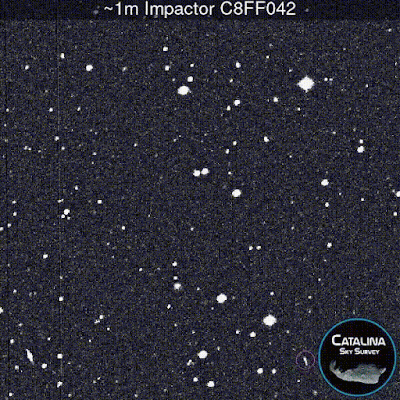On 2023 February 12.8 (20:18:07 UTC), K. Sarneczky found a small asteroid with the 0.60-m Schmidt + CCD of the Piszkéstető Observatory in Hungary (K88 MPC code) that was soon after put on the NEOCP list with the provisional designation Sar2667 for the follow-up by other observers. The object was subsequently imaged by many observers around the world and various impact assessment systems found a 100% impact probability in the area of the English Channel on Feb. 13 between 02 and 04 UTC. This is the second discovery by Sarneczky of an impactor, following the 2022 EB5 event in March 2022.
M.P.E.C. 2023-C103 issued subsequently on 2023 February 13 at 04:13 UT assigned the official designation 2023 CX1 to Sar2667 with the following comment:
K. Sarneczky reported a new NEOCP candidate observed at GINOP-KHK (K88). Rapid follow-up from multiple sites indicated an impact with the Earth's atmosphere on February 13 03:00 UTC near the coast of Normandy, France, as determined by imminent impact monitoring services such as JPL's Scout, ESA's Meerkat and MPC's internal warning system.
Map of the impact zone predicted to occur a few kilometers from French coast, North-East of Le Havre. Click on it for a bigger version.
 |
| Credit: IMO |
2023 CX1 was a small Aten asteroid with an estimated size of ~1.0 m (based on the object's absolute magnitude H=32.6).
Below you can see the discovery images of 2023 CX1 taken at Konkoly Observatory's Piszkéstető Station with the 0.60-m Schmidt telescope. Three 4x25 sec stacked images with the object at 19.5 magnitude.
 |
| Credit: K. Sarneczky |
We performed follow-up measurements of this object while it was still on the NEOCP webpage and about 4 hours before the impact. Images obtained at the ALMO Observatory, in Padulle, Italy (G18 MPC code). Click on the image below for a bigger version.
 |
| Credit: A. Valvasori, E. Guido |
As expected, 02h 59min UT, 2023 CX1 entered the Earth atmosphere, producing a very bright fireball that was reported by dozens of witnesses and recorded on video by many thanks to favorable weather conditions over the involved densely populated area and the alert issued few hours in advance by astronomers. Below some of the best videos and photos posted on the web.
 |
| Credit: Gijs de Reijke |
 |
| Credit: BNO News |
 |
| Credit: Kevin |
 |
| Credit: KrisztiUk |
2023 CX1 became the 7th asteroid to be discovered before entering the Earth atmosphere. The first time it happened was with asteroid 2008 TC3, the second was with asteroid 2014 AA, the third was 2018 LA that impacted Earth on 02 June 2018, the fourth was with asteroid 2019 MO that impacted Earth on 22 June 2019 , the fifth was the asteroid 2022 EB5, the sixth was the asteroid 2022 WJ1 less than 3 months ago. Another space impacting object discovered prior to its to atmospheric entry was WT1190F but it is thought to have been a space debris, possibly the translunar injection module of Lunar Prospector. For more info about 2008 TC3, 2014 AA, 2018 LA, 2019 MO, 2022 EB5 and 2022 WJ1 see also:
http://remanzacco.blogspot.it/2008/10/small-asteroid-2008-tc3-to-hit-earth.html
http://remanzacco.blogspot.com/2008/10/2008-tc3-animation.html
http://remanzacco.blogspot.com/2008/10/2008-tc3-update-impact-flash-imaged.html
http://remanzacco.blogspot.com/2008/11/2008-tc3-trail-imaged-over-northern.html
http://remanzacco.blogspot.it/2009/02/2008-tc3-fragments-recovered.html
http://remanzacco.blogspot.com/2014/01/small-asteroid-2014-aa-hit-earths_2.html
https://remanzacco.blogspot.com/2018/06/small-asteroid-2018-la-impacted-earth.html
https://remanzacco.blogspot.com/2019/06/small-asteroid-neocp-a10eom1-impacted.html
https://remanzacco.blogspot.com/2022/03/small-asteroid-2022-eb5-neocp-sar2593.html
https://remanzacco.blogspot.com/2023/02/small-asteroid-2022-wj1-neocp-c8ff042.html
http://remanzacco.blogspot.com/search/label/asteroid%20impact
by Ernesto Guido











